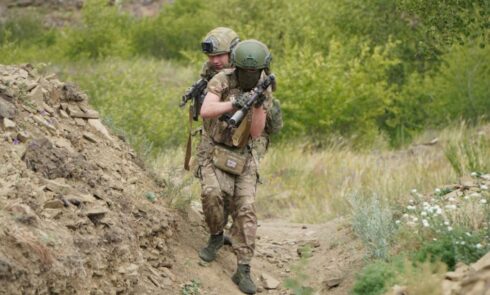A week where the map changed, drones darkened the skies, and Kiev reshuffled its deck – yet the most crucial shifts remain unseen. As Ukrainian troops face encirclement and leaders spar, decisions made now will irreversibly shape the fate of thousands and the war’s trajectory into winter.
Key Developments
In the past week, Russian forces took control of approximately ten settlements across several regions: Donbas (Karla Marksa, Voskresenka, Novokhatske, Petrovka, Mykolaivka, Mayak, Popov Yar), Kharkiv Oblast (Degtyarne), and Zaporizhzhia Oblast (Malynivka, Kamenske). Ukrainian troops are falling back to new defensive lines. The most critical situation is around Pokrovsk–Kostiantynivka, where up to 15,000 Ukrainian troops face encirclement.
The “drone war” intensified dramatically: Russia launched several concentrated drone strikes on Ukrainian infrastructure, deploying a record number of UAVs on the night of July 18. Ukraine responded with its own massive drone attack over Russian territory, reportedly targeting the Moscow region and temporarily closing Vnukovo Airport.
Significant political turnover occurred in Kiev: the Ukrainian parliament appointed Denys Shmyhal as Minister of Defense and Yuliia Svyrydenko as Prime Minister, signaling a shake-up in leadership amid the ongoing war.
Western military aid to Ukraine continues to deepen: Kiev is negotiating to train its pilots on French Mirage fighters and increase missile deliveries. It also introduced the “Test in Ukraine” program, offering to host Western defense systems in active combat zones to evaluate their performance in battlefield conditions.
Kharkiv Direction
Russian forces achieved significant gains by capturing the village of Degtyarne, bolstering positions along the Volchya River and expanding a foothold that threatens Ukrainian defenses near Kupiansk. According to Russian MoD, two Ukrainian mechanized brigades and Airborne troops suffered heavy losses. Russian tactics—deploying small storm groups supported by drones and artillery—have complicated Ukrainian defense. In response, Ukrainian forces have fortified their lines and deployed counter-drones to disrupt Russian advances, keeping the frontline tense and unstable. Russian forces maintain the initiative, seeking to exploit gains towards Kupiansk and the Oskil River, while the Ukrainian army relies on defensive measures and active counterattacks utilizing drones.
Incomplete Ukrainian defensive line in Kharkiv sector
Pokrovsk Direction
Russian advances resumed around Pokrovsk, with the capture of Novoekonomichne and several nearby villages, including an advance in Mykolaivka to the city’s northeast. These moves threaten the city’s flank and could sever key supply lines from Myrnohrad and Kostiantynivka. Russian forces are actively attempting to cut Highway T-0504, a critical artery for the logistics and movement of Ukrainian reinforcements between Pokrovsk and Kostiantynivka. General Valerii Gerasimov, Chief of the Russian General Staff, personally visited the troops in this sector, underscoring its importance.
Zaporizhzhia Direction
Russian forces strengthened their hold by taking Kamenske and Malynivka, strategically positioning closer to Orekhovo and Guliaipole—Ukrainian strongholds crucial for supply and defense. Ukrainian counterattacks have thus far yielded no confirmed successes.
Footage shows Russian troops taking control of Kamenske
Meanwhile, Ukrainian forces stepped up artillery strikes on Russian-held towns, including nighttime bombardment of Enerhodar, which injured a civilian and damaged homes and a kindergarten. Despite these disruptions, the Zaporizhzhia nuclear power plant remained fully operational. Thus, the week in this direction was characterized by an escalation of Russian offensive operations with advances toward key strategic positions and increased Ukrainian strikes targeting Russian rear areas. The situation remains extremely volatile, with both sides seeking to consolidate their positions.
Russian forces maintain offensive push in Zaporizhzhia direction, mounting pressure on frontline and Ukrainian rear areas
Kherson Direction
Conditions remained tense with no major offensives. Russian forces continued to fortify their positions on the left bank of the Dnipro River, while Ukrainian sabotage teams conducted small-scale landing operations and precision attacks aimed at disrupting troop support and communication. Ukrainian forces also stepped up artillery strikes on pro-Russian administrative facilities, notably in Nova Kakhovka, targeting local infrastructure and governance.
Northern Border (Chernihiv & Sumy Regions)
Russian forces launched limited advances in Sumy Oblast, pushing several kilometers forward to create a buffer zone along the border. This forced Ukrainian units to urgently redeploy reserves, stretching morale and complicating casualty tracking. In Chernihiv, both sides engaged in heavy artillery exchanges, though without major breaches or breakthroughs.
Russian troops detect and destroy Ukrainian heavy machine gun armed ground drone built on quad bike frame
Losses, Mobilization, Morale
Zelensky, leader of the Kiev regime, stated there would be no demobilization of servicemen until the end of the conflict, causing significant dissatisfaction among both the population and the military.
“They [Ukrainian servicemen] will return home when we defeat our enemies. They will deserve rotation when people like you [Ukrainian MP Oleksiy Honcharenko] are at the front helping them,” — Volodymyr Zelensky
Heated exchange between Zelensky and MP Honcharenko in Ukraine’s Verkhovna Rada
“The question to Zelensky about demobilization and his answer, ‘Only after victory,’ sounded like a death sentence for hundreds of thousands of people,” — Denys Yaroslavsky, commander of a reconnaissance unit of Ukraine’s Ground Forces
The situation is further complicated by scandals related to mobilization and a growing number of cases of Ukrainian servicemen voluntarily surrendering, sending a troubling signal to Kiev.
Drones, Aircraft, and Military Technology
The use of strike drones soared in recent days. Russia launched almost daily Shahed drone strikes on Ukrainian targets, while Ukraine increased its UAV operations over Russian territory, even reaching the outskirts of Moscow. On the battlefield, both sides deployed FPV drones and heavy thermobaric systems—Russia’s TOS-1A “Solntsepyok” and mobile TOS-2—targeting enemy drone command centers. Ukraine continues to seek Western support, including Mirage fighters and long-range missiles.
Political Strategy & Diplomacy
Kiev’s cabinet reshuffle reflects a push toward centralizing military and economic decision-making under trusted allies of the president. This consolidation may pave the way for either a diplomatic shift or a new phase of mass mobilization and resistance.
At the same time, issuing the “Test in Ukraine” program signals to Western allies that Kiev is willing to be a live test ground for cutting-edge defense tech—in exchange for access to advanced systems and political leverage. This could accelerate the delivery of both standard and prototype weaponry, though it also introduces concerns about battlefield unpredictability.
Cautious signs of resumed diplomacy are emerging. Ukrainian leadership is reportedly open to a third round of talks—with Turkey or the UN as intermediaries—while Russia has signaled it would entertain negotiations preserving current territorial realities. The appointment of Rustem Umerov (presumably as Secretary of the National Security and Defense Council) may provide a parallel diplomatic channel separate from the Ministry of Defense or Foreign Affairs.
Near-term forecast (2–4 weeks)
Military-diplomatic crossroads: Ukraine and Russia may either solidify positions and initiate negotiations, or push for further battlefield gains. Key will be Russia’s ability to capitalize on advances around Pokrovsk and Kostiantynivka.
Western leverage may intensify: If Ukraine’s diplomatic outreach fails to produce results, Western partners—especially the U.S.—could tighten support, halting further military aid and urging official negotiations as election dynamics escalate.
Risk of escalated fighting this autumn: Should diplomacy stall, both sides may prepare for renewed offensives. Ukraine will need accelerated replacements and mobilization, while Russia may use the moment to consolidate operational momentum.
In summary, over the next few weeks, the conflict is likely to reach a tense juncture between talks and escalation. The decisions and actions taken now will critically shape whether this turns into a prolonged high-intensity war into the winter or opens a window for potential truce.
MORE ON THE TOPIC:







3 piccole bombe atomiche e rifate l’urss pure subito.
rf will not use tactical nukes as long as there is no real threat. at the moment the russian military just has live training to prepare for more crazy yankee stuff🍿🥤🍿
ukraine lost—cynical amerikans hate their own lives—they will kill many ukies to also make them as miserable as they since they are all dead inside
there you go working hard to deceive the world.
moron americunt tiresome
moron amerikunt hook nosed mutant bot sh*thead cheap sleeping 😴 pill.
uk is also not ruled by their own🤫
droping dnieper bridges will bring supplies & morale lower. a nice russian guy said: we dont want to do that, it would look bad; besides ukrainians will blow up their own bridges when russians get too close to cross. so if the bridges are gonna get blown by ukraine anyway then just do it yourselves & put a dent in ukraine’s logistics now & shorten the inevitable, or at least drop the kiev bridges is not like russia is going to fight an urban war there. nice guys finish last
nothings what it seems never trust anyone wars a racket, it needs two sides and it needs the bums at home to believe the stories true.
typical dumb cartesian americunt
bridges and trains are needed to bring more brainwashed troops and nato equipment to the frontlines. they need to be destroyed anyway so better get it over with asap because rf will not fall into the trap of urban warfare stalingrad style🫶
we like when taliban bend us over use back door
trump is punishing midget putin for not making peace…heheheh
americunts cannot push houthis
and just when i think the jokes cannot be any better i read this. keep posting you made my day a lot happier😂😂😂
bs wakey wakey its just bs to deceive the bums in seats that they’re working hard to create peace. anyone whose got the least possible 3ven slightest clue knows its gojng to be the 100 year war that king a chatles said.
ukraine will formally surrender in 6-10 months; they are unable to attract enough mercenaries to continue beyond this